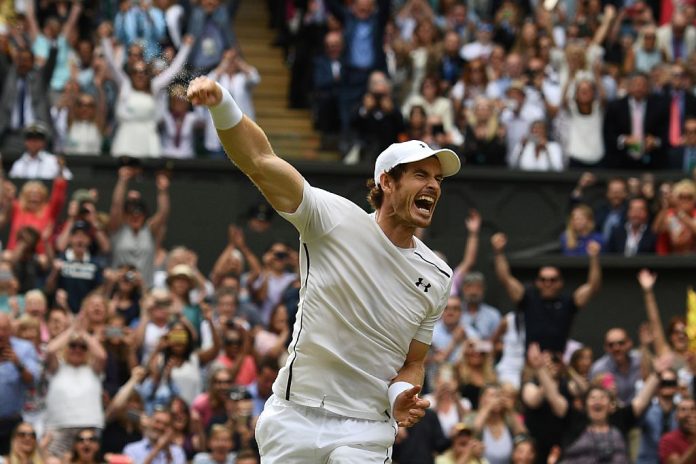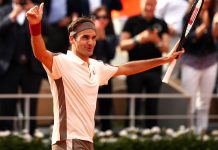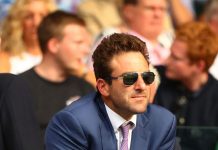Wimbledon, England—
Bill Simons
In the old days, when Andy Murray lost one big match after another, Britain’s papers would rush to print cruel headliness. One read: HUMILIATED AT FOOTIE, RUGBY, NOW MURRAY CRASHES OUT OF WIMBO (AT LEAST WE’RE TIDDLYWINKS CHAMPS).
Today the Observer featured a headline that was a desperate plea: WEATHER TERRIBLE, STERLING TUMBLING, POLITICS DISMAL, EURO FLOPS (NOT WALES), BREXIT COMING, RECESSION LOOMING – ANDY PLEASE CHEER US UP.
And there was good reason today that Murray might lift British spirits in today’s final. The Scot embraces the big moment on the big stage. Britain’s “Mr. History” won the Olympics on Centre Court, in 2013 became the first Brit in 77 years to win Wimbledon, and almost single-handedly won the Davis Cup for Britain last December. Plus, his severe sage – the grim, sullen Ivan Lendl – was back in his corner, while his nemesis Novak Djokovic, who beat him earlier in the French and Aussie finals, was back in Serbia.
Thanks to a lanky American, Andy would be spared from facing the sizzling Serbian who crushes him. SLAM BAM THANK YOU SAM, said one headline in honor of Sam Querrey, who dismissed Novak in the third round.
Now for the first time in his 11 Grand Slam finals, Murray could breathe. He would not have to face Novak or Roger Federer. He would be the favorite against big Milos Raonic, whom he had beaten five straight times, including in the final of the Queens warm-up just three weeks ago.
RUTHLESS MURRAY READY TO REPEL THE NEXT GENERATION read this morning’s headline. And clearly Milos Raonic is the leading light of the ATP’s next wave. Just compare him with the talented Nick Kyrgios. The Aussie is carefree, volatile and adrift. He doesn’t have a coach or a compass. Milos has three coaches and a sense of purpose and destiny like few others. Call it drive, commitment or simply the power of the human will – the man doesn’t leave a stone unturned.
Neither did his parents. Geeks in Montenegro, both his mom and dad were engineers who fled the chaos in the Balkans to a land of serenity and opportunity – Ontario.
Never mind that a junior tennis program said “No way” to Milos when the kid was eight. So what? The boy soon was hitting balls from a machine for two hours a day (thanks to his Dad, who knows nothing about tennis and whose greatest asset is that he has never given Raonic any advice).
Anyway, Raonic soon began to “engineer” his big game, gaining wins in modest places. But the lumberjack blaster was quickly typecast. Jim Courier said he “emotes like his [stiff] hair.” Bruce Jenkins noted that Raonic was “fashioning a preppy, slicked-down hairstyle that seems impervious to the elements. He looks like the tennis pro on a luxury liner. There’s no actual court, but man, he looks good.”
More to the point, the Guardian observed that “Raonic’s mechanical manner…can sometimes create the impression of a tennis cyborg, an unsmiling, unflinching severe automaton, the first threat posed to the future livelihood of ball machines by a human.”
But Raonic is no robot – he just looks that way. He’s got great heart. In Australia he dedicated a match to the Canadian victims of a mass murder. He’s cultured. When he talks art, people listen. And he’s deep – a product of the Arthur Ashe, Michael Chang, Todd Martin school of cerebral reflection. Here he came from behind from two sets down (against David Goffin) for the first time in his career. Then he came from behind to beat Federer in a match in which Pat Cash said, “He became a man.”
But could this big man prevail in his first Slam final and become the first Canadian to win a Grand Slam? Raonic’s consultant John McEnroe said Milos “shouldn’t bottle up his emotions, he should lay it all out there. To beat Murray he would – like Pete Sampras used to do – have to take the racket out of his foe’s hands.”
But Raonic is no Sampras. Yes, his movement and quickness are better than the other huge men in tennis. But his game is flawed. He just doesn’t have the flash quickness that’s a necessity.
Murray today proved he is a faster, better athlete who manages a tennis match with a tactical mastery. He was calm. Murray’s painful losses in the past didn’t phase him. Simon Briggs said Andy’s mental state was “as unflappable as the Dalai Lama’s.”
The Scot doesn’t overdo things. He doesn’t go for too much, but he steps up with a steely nerve whenever the caution light flashes. Then his serve picks up and his passing shots dip. So often Raonic was mystified.
Plus Murray, along with Djokovic, has the best return of serve on this or (we presume) any other planet. He doesn’t exactly know why. “I’ve just done it since I was a kid,” he says. But he does practice returns for at least 30 minutes a day.
Donald Young said having a serve like Milos’ is like “having a whole bunch of get-out-of-jail cards.” Only a few can neutralize his 140 mph blasts. But Andy did. Milos had just eight aces, far below his previous Wimbledon average of almost 26. His usual 67% of first serves won was also way down.
Comfortable, moving well, seeing the court well and hitting over three times more winners than errors, Murray broke in the seventh game of the first set. Raonic showed his inexperience (or was it his lack of quickness?) at the start of the critical second set tiebreak when he made a hash of a short backhand. Murray pounced. His groundies froze the Canadian lumberjack and Murray wrapped up the second set tiebreak 7-3.
In the fifth game of the third set, Raonic finally gained two break points on Andy’s serve, but the Brit served brilliantly and hit a sublime backhand pass to hold. Then in the third set tiebreak, he again quickly passed an almost hapless Raonic and got the Canadian on the run to claim the tiebreak and the match 6-4, 7-6(3), 7-6(2).
Murray noted, “I was hitting the ball clean from the back…I wasn’t leaving too many short balls for him to dictate…There weren’t many rallies where [I] gave up control. I was moving the ball around well…I made quite a lot of returns, second-serve returns as well, and just tried to build pressure by getting as many returns back in play as possible. It paid off in the tiebreaks.”
It paid off in the record books too. Murray’s second Wimbledon and third major stopped his streak of three straight losses in Slam finals, and it put an explanation point on what a golden era we now enjoy. The Fab Four – Novak, Roger, Rafa and Andy – have incredibly won 39 of the last 43 Slams.
All of this could lead us to ask, so what’s going to happen when Novak gets back into the ring? When is someone who was born in the 1990s finally going to crash the party? Or can Mr. Murray do it again?
But forget it. The London sky is blue today. Mr. Murray did his job splendidly. The British have been buoyed. And now the headline in the Telegraph read, “At last, something for the whole nation to cheer.”



















